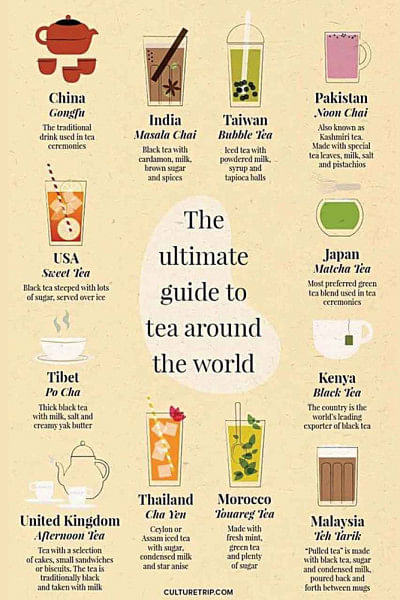History of tea

Having tea has always enmeshed with our favourite past times, be it sitting in the garden reading a book, having a family discussion, or even sharing a cup of tea with strangers in a nearby 'tong,' striking up interesting conversations and new friendships. Since ancient times to the current age, tea has become one of the world's ubiquitous drinks, changing its numerous traditions and tastes as its popularity encompasses borders, traditions, nations, and rituals.
The origin of world's second most popular beverage is multi-layered and infused with spiritual and philosophical connections remaining one of the East's greatest treasures.
According to legend(s), the discovery of tea was a happy accident when some leaves blown by the wind had ended up in the water boiled by Chinese emperor Shen Nong (2737 – 2697 BC). Tasting the heated water with leaves, he was delighted and stimulated by the strong flavour. The leaves were reportedly said to be from the plant Camellia sinensis and the beguiling flavours compelled the emperor to tell his subjects to go for extensive planting of tea.
According to Helen Saberi's brilliant book on tea, "Tea: A Global Study," he had solemnly declared to his subjects: 'Tea gives vigour to the body, contentment to the mind and determination of purpose.'
The Japanese origin of tea dates back to the Buddhist sage named Bodhidharma who travelled from India to China.
In dedicating seven years of devotion in meditation, he noticed that he was falling asleep, for which he cut off his eyelids. He threw away his eyelids, from which, legend has it, a tea plant grew.
Another interesting source, which is much closer to home, is that an ancient Buddhist scholar, Wu Li Zhen had brought seven tea plants from Assam and planted them in the Meng mountain in Sichuan, earning tea grown there the name of Gan Lu meaning "sweet dew."
Despite its innumerable origins, tea remains firmly rooted in the histories of modern-day China and India. Tea had reached its initial zenith of popularity in the 6th century multi-ethnic Tang Dynasty in China as it frequently cross pollinated between different cultures and brought into a new vogue of better-quality taste.
Tea culture developed with numerous treatises, poems, and pamphlets penned on the refreshing characteristics on tea. Monks, priests, administrators, and scholars all relied on tea for concentration and nourishment. In many ways, it was seen as a stress reliever. Tea also became a homely beverage, drunk daily and served to guests.
Tea cultivation spread to other parts of China creating a change in flavour and ritual. Just like the coffee houses of the Ottoman empires, teahouses flourished through the centuries becoming centres of high artistic culture, where mainly the wealthy classes came to drink tea, socialise and debate about the burning issues of the days.
Despite tea grown and drank in India, it was mainly relegated to parts of North-eastern India including Assam. The popularity of tea in the subcontinent ran parallel to the subsequent colonisation of the whole area. A Scottish major called Robert Bruce had come across tea very similar to the Chinese variety in Assam, which he was compelled to report to the imperial authorities who themselves took a liking to its taste.
Tea had ventured into modern day Britain through the Dutch, who themselves derived tea from the East Indies, which is today's Indonesia.
Concerned about losing the monopoly of tea production to China, the empire vigorously promoted tea culture in India, prompting new tea cultivation sites and estates, which oversaw their plantations and growth.
Tea had entered the battle of colonisation. This marked the beginning of a new, flourishing tea industry in India and an end to reliance on Chinese grown tea.
Tea slowly crept up into the minds of Indians with the establishment of the famous Irani cafes being set up in the bustling cities of Mumbai by Zoroastrians from Iran.
Irani cafes brought in new and exciting flavours of tea from both within India, as well as China and the Far East due to strong trading routes set up at that time. The significance of tea while being intact has always been accommodating in line with taste, geography, and tradition.
Photo: Collected

 For all latest news, follow The Daily Star's Google News channel.
For all latest news, follow The Daily Star's Google News channel. 



Comments